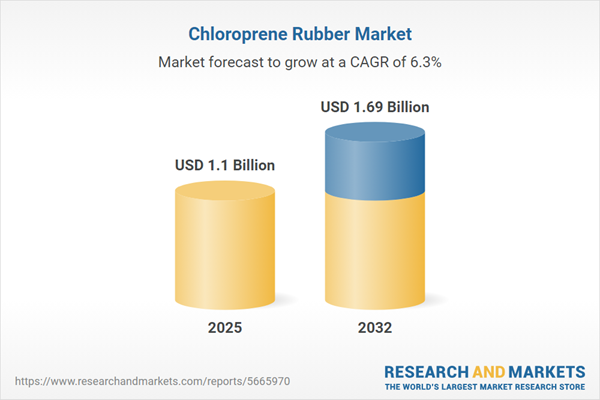Speak directly to the analyst to clarify any post sales queries you may have.
Senior executives in the chemicals industry are navigating accelerated regulatory pressures and evolving sustainability criteria, making clear chloroprene rubber market intelligence essential for strategic planning and risk management.
Market Snapshot: Chloroprene Rubber Market Size and Growth Outlook
The global chloroprene rubber market is projected to increase from USD 1.04 billion in 2024 to USD 1.10 billion in 2025, reaching USD 1.69 billion by 2032. Steady expansion is driven by persistent demand across automotive, adhesives, and construction sectors, highlighting the market’s enduring value in critical supply chains. Executive procurement and strategy teams are challenged to address increasing expectations for digital transformation, sustainable practices, and improved supply chain resilience. This dynamic environment is reshaping operational models, intensifying competition, and requiring agility in sourcing, compliance, and production processes.
Scope & Segmentation
This comprehensive analysis equips senior leaders with actionable insights into the chloroprene rubber market, supporting tailored approaches for sourcing, product innovation, and regional operations. Key coverage areas and their relevance include:
- Product Forms: Assessment of block, powder, and latex types (coagulated and concentrated) gives manufacturers and buyers strategic guidance in selecting suitable formats for specific functional, technical, or processing criteria.
- Key End-Use Applications: Details usage in automotive parts, adhesives, sealants for construction, and heavy industrial components, clarifying why chloroprene rubber’s durability and heat resistance remain critical in demanding environments.
- Regional Analysis: Provides targeted review of the Americas, Europe, Middle East and Africa, and Asia-Pacific. This supports decision-makers in evaluating how regulatory trends, infrastructure developments, and regional technology adoption influence supplier strategies and operational productivity.
- Innovation Drivers: Explores developments in catalysts, digital manufacturing, and bio-based feedstocks. Highlights include how these trends help companies meet sustainability, compliance, and efficiency goals, fostering process advantages and differentiating products in a competitive market.
- Key Companies: Profiles major producers such as Denka Co., Ltd.; LANXESS AG; Tosoh Corporation; Zeon Corporation; Jiangsu Sanmu New Materials Co., Ltd.; Liaocheng Dongyue Group Co., Ltd.; Kumho Petrochemical Co., Ltd.; Mitsui Chemicals, Inc.; JSR Corporation; and Wacker Chemie AG. This coverage reveals innovation paths and anticipated market leadership shifts.
Key Takeaways for Senior Stakeholders
- Chloroprene rubber’s reliability in demanding conditions reinforces its status as a preferred choice for industries prioritizing long-term asset integrity and operational continuity.
- Adoption of advanced catalyst technologies and process improvements allows companies to enhance ESG alignment and cost control.
- Diversifying procurement channels, including recycled material streams, supports organizations in reducing risk and anticipating compliance evolution.
- Greater use of analytics and automation in production and supply chain management enhances real-time decision-making, enabling more adaptive procurement strategies.
- Establishing regional partnerships and localizing supply chains enables agility in response to changing regulations and mitigates logistical disruptions.
- Increasing domestic production capabilities strengthens operational resilience, particularly where supply routes may be restricted by shifting geopolitical or transport contexts.
Tariff Impact: 2025 United States Trade Measures
Forthcoming US tariffs in 2025 are prompting chloroprene rubber manufacturers to revise pricing, supply chain structures, and distribution approaches. Firms with domestic operations are optimizing local production to reduce exposure, while international producers diversify sourcing and distribution to maintain flexibility in uncertain trade conditions. These strategies help sustain demand responsiveness and ensure continuity as trade arrangements restructure.
Methodology & Data Sources
This report draws on analysis of public company financials, regulatory documents, expert supplier interviews, and specific industry case studies. Proprietary benchmarking and data-driven analytics ensure the recommendations address the full spectrum of strategic procurement, risk reduction, and long-term planning needs.
Why This Report Matters
- Offers senior executives timely, actionable chloroprene rubber market insights to drive regulatory compliance, operational excellence, and strategic resource allocation.
- Supports organizations in strengthening supply chain resilience, enhancing risk management, and enabling faster adaptation to complex and evolving global standards.
- Empowers leadership to act decisively through in-depth coverage of innovation, technology trends, and evolving regional market dynamics.
Conclusion
This report gives leadership teams a critical knowledge foundation, enabling resilient strategy development and informed decision-making as the chloroprene rubber market landscape evolves.
Additional Product Information:
- Purchase of this report includes 1 year online access with quarterly updates.
- This report can be updated on request. Please contact our Customer Experience team using the Ask a Question widget on our website.
Table of Contents
3. Executive Summary
4. Market Overview
7. Cumulative Impact of Artificial Intelligence 2025
Companies Mentioned
The companies profiled in this Chloroprene Rubber market report include:- Denka Co., Ltd.
- LANXESS AG
- Tosoh Corporation
- Zeon Corporation
- Jiangsu Sanmu New Materials Co., Ltd.
- Liaocheng Dongyue Group Co., Ltd.
- Kumho Petrochemical Co., Ltd.
- Mitsui Chemicals, Inc.
- JSR Corporation
- Wacker Chemie AG
Table Information
| Report Attribute | Details |
|---|---|
| No. of Pages | 188 |
| Published | November 2025 |
| Forecast Period | 2025 - 2032 |
| Estimated Market Value ( USD | $ 1.1 Billion |
| Forecasted Market Value ( USD | $ 1.69 Billion |
| Compound Annual Growth Rate | 6.3% |
| Regions Covered | Global |
| No. of Companies Mentioned | 11 |









